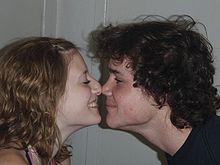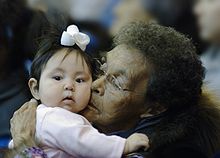Eskimo kiss
In Inuit culture, the gesture is known as a kunik, and consists of pressing or rubbing the tip of one's nose against another's cheek.
[1] In non-Inuit English-speaking culture, two people Eskimo kiss by rubbing the tips of their noses together.
When early Western explorers of the Arctic first witnessed Inuit nose rubbing as a greeting behavior, they dubbed it Eskimo kissing.
Among the Inuit, kunik is a form of expressing affection,[1] usually between family members and loved ones or to young children,[2] that involves pressing the nose and upper lip against the skin (commonly of the cheeks or forehead) and breathing in, causing the loved one's skin or hair to be suctioned against the nose and upper lip.
[citation needed] The greeting was described in reports of Kerlungner and Wearner, part of a group of Alaskan Native people touring the United States with entrepreneur Miner W. Bruce in the 1890s: "Mr. Bruce yesterday instructed Kerlungner and Wearner that in this country they should not rub noses, and to close the lesson the two young women kissed each other in the new style for a beginning, both seeming to fear that they looked silly as they did it.


